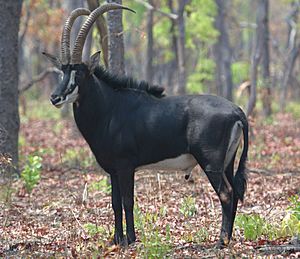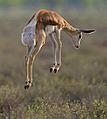Bovid facts for kids
Quick facts for kids Bovids |
|
|---|---|
 |
|
| Sable antelope | |
| Scientific classification | |
| Kingdom: | |
| Phylum: | |
| Class: | |
| Order: | |
| Family: |
Bovidae
Gray, 1821
|
Bovids are a large family of mammals. They are known for their special hooves and often, their horns. The name "Bovidae" comes from the Latin word bos, which means "ox." This family includes many animals you might know, like cattle, goats, sheep, and different kinds of antelopes.
Bovids are found all over the world. You can see them on every continent except South America, Australia, and Antarctica. There are 143 different living species in the bovid family.
One cool thing about bovids is their hooves. They are called "even-toed ungulates." This means their hooves are split into two parts, like two toes. They also have a special way of digesting their food. They are ruminants, which means they have a multi-chambered stomach. This helps them get the most nutrients from the plants they eat. This special digestive system has helped them become very successful.
Bovids first appeared a long time ago, during the Miocene period. Today, some of the most important domestic animals, like cows, sheep, and goats, are part of this family.
What are Bovids?
Bovids are a diverse group of plant-eating mammals. They are known for their strong bodies and, in many cases, their horns. These horns are usually permanent and do not branch out like deer antlers. Both males and females can have horns, but they are often larger in males.
How Bovids Eat
As herbivores, bovids eat only plants. They are ruminants, which means they chew their food, swallow it, and then bring it back up to chew it again. This process helps them break down tough plant material. It makes their digestion very efficient. This system allows them to get a lot of energy from grass and leaves.
Where Bovids Live
Bovids live in many different habitats. You can find them in grasslands, forests, mountains, and even deserts. They are very adaptable. Their wide range shows how successful they have been at surviving in various environments.
Types of Bovids
The bovid family is huge, with many different groups. Here are some of the main subfamilies:
- Aepycerotinae: This group includes just one animal, the impala.
- Alcelaphinae: This subfamily has animals like the wildebeest and their relatives.
- Antilopinae: This group includes many types of gazelles and similar antelopes.
- Bovinae: This is where you find cattle, bisons, and other large bovids.
- Caprinae: This subfamily includes goats and sheep.
- Cephalophinae: This group contains the small duikers.
- Hippotraginae: This subfamily includes various types of large antelopes.
- Panthelopinae: This group has only the Tibetan antelope.
- Peleinae: This group includes only the grey rhebok.
- Reduncinae: This subfamily contains more types of antelopes.
Images for kids
-
The gemsbok has special markings on its face and legs. These might help them communicate.
-
American bison skeleton (Museum of Osteology)
-
Blackbuck antelopes
-
Blue wildebeest fighting for dominance.
-
Merino wool is very soft and valuable.
-
Drinking horn made by Brynjólfur Jónsson of Skarð, Iceland, 1598.
See also
 In Spanish: Bóvidos para niños
In Spanish: Bóvidos para niños
















